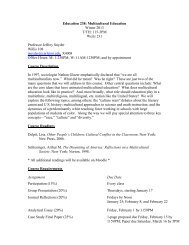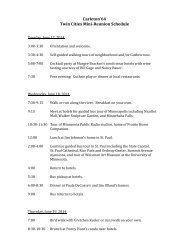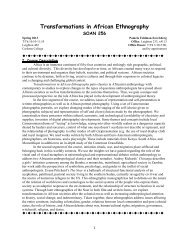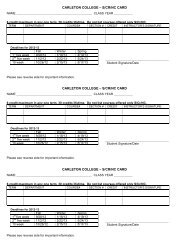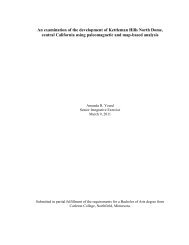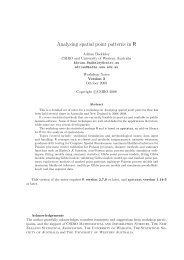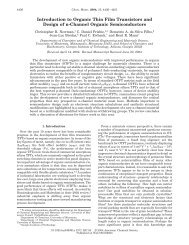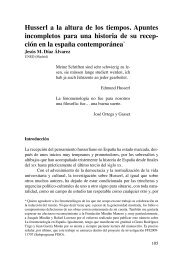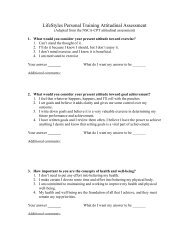babababababababababababababab the druid ... - Carleton College
babababababababababababababab the druid ... - Carleton College
babababababababababababababab the druid ... - Carleton College
You also want an ePaper? Increase the reach of your titles
YUMPU automatically turns print PDFs into web optimized ePapers that Google loves.
The O<strong>the</strong>r Druids<br />
by Isaac Bonewits<br />
Modern Introduction<br />
This article is taken verbatim from DC(E), except for spelling adjustments<br />
and such, but I have added extra bracketed paragraphs,<br />
i.e. “{xxxxx},” from Isaac’s later 1979 Pentalpha version (titled “Druidism—Past,<br />
Present & Future”) where he expanded certain ideas<br />
(most notably <strong>the</strong> first few of <strong>the</strong> following paragraphs). I’ve dealt<br />
with this issue enough to leave it at that. As an overview of past<br />
“Druidic” groups, it is a nice compilation. See my own up-to-date<br />
bibliography at <strong>the</strong> end of Part Eight for o<strong>the</strong>r good overviews of<br />
Paleo, Meso and Neo-Druidical movements.—Scharding<br />
The Article<br />
{“Druidism is a topic that has been fascinating people for thousands<br />
of years, yet man folks (even within <strong>the</strong> Neopagan community)<br />
are confused about what is actually known and unknown, fact and<br />
fancy (whatever those words may really mean), about <strong>the</strong> various<br />
phenomena that have all been labeled Druidism. The purpose of<br />
this article will be to briefly outline <strong>the</strong> current consensus among<br />
scholars about Paleopagan, Mesopagan and Neopagan Druidism.<br />
Comments by those having more accurate data will be welcomed by<br />
<strong>the</strong> author.”}<br />
{“It should be pointed out, however, that <strong>the</strong> author is working<br />
strictly on <strong>the</strong> traditional, “earthplane,” historical level of reality. It is<br />
not unusual for religious and philosophical movements to have legends<br />
about <strong>the</strong>ir origins, in fact, all of <strong>the</strong> world’s “great religions”<br />
have <strong>the</strong>m. The existence of such mythic material says nothing about<br />
he validity of spiritual, philosophical or magical concepts such groups<br />
may have to offer <strong>the</strong>ir members or observers; especially since many<br />
of <strong>the</strong> legends about <strong>the</strong> origins of groups were created for archetypal,<br />
mystical and o<strong>the</strong>rwise symbolic purposes and are not necessarily<br />
meant to be taken literally.”}<br />
{“Earth-plane reality is not <strong>the</strong> Dreamtime; many modern religious<br />
and magical orders are based on psychic ra<strong>the</strong>r than physical<br />
links to <strong>the</strong> past and that past is often one that may never have<br />
existed physically on this planet. But profound metaphysical insights<br />
are still profound, regardless of whe<strong>the</strong>r or not those promulgating<br />
<strong>the</strong>m are accidentally or deliberately passing on unprovable tales about<br />
heir origins. Modern Druids are as likely as modern Witches to<br />
suddenly go mystical and romantic when hard historical questions<br />
are brought up. Some avoid <strong>the</strong> problem entirely by citing “reincarnation<br />
memories” or o<strong>the</strong>r divinatory techniques as <strong>the</strong> sources of<br />
<strong>the</strong>ir beliefs. Such sources deserve respectful analysis but at<br />
parapsychology’s current state of development, historians do not yet<br />
have <strong>the</strong> proper mental tools to adequately perform <strong>the</strong> necessary<br />
evaluations.”}<br />
{“The term “Pagan” comes from <strong>the</strong> Latin paganus, which appears<br />
to have mean “country dweller, villager, or hick,” and not necessarily<br />
in a polite way. The Roman army seems to have used <strong>the</strong><br />
term to mean “a civilian,” and <strong>the</strong> Roman Church later used it to<br />
refer to those who were not part of “<strong>the</strong> Armies of <strong>the</strong> Lord,” i.e.,<br />
those who were nonchristian. After 1500 years of propaganda, <strong>the</strong><br />
term became synonymous in many people’s minds with “a<strong>the</strong>ist,<br />
devil worshipper, or hea<strong>the</strong>n” (hea<strong>the</strong>n, of course, means “people of<br />
<strong>the</strong> heath, where hea<strong>the</strong>r grows”). Today, most people who define<br />
<strong>the</strong>mselves as Pagans use <strong>the</strong> word as a general term for “native and<br />
natural religions, usually poly<strong>the</strong>istic, and <strong>the</strong>ir members.”}<br />
{“This is <strong>the</strong> sense in which this author uses it. The term<br />
“Paleopagan” refers to <strong>the</strong> original poly<strong>the</strong>istic tribal faiths of Europe,<br />
Africa, Asia, <strong>the</strong> Americas and Australia, when <strong>the</strong>y were still<br />
practiced as intact belief systems. “Mesopagan refers to those movements<br />
founded as attempts to recreate or revive what <strong>the</strong> founders<br />
317<br />
thought of as <strong>the</strong> (usually European) Paleopagan faiths of <strong>the</strong>ir ancestors;<br />
but which were developed by those founders within <strong>the</strong> basically<br />
mono<strong>the</strong>istic or dualistic worldview of Judaism, Christianity<br />
and Islam. “Neopaganism” refers to <strong>the</strong> recent attempts to revive<br />
what <strong>the</strong> founders perceived as <strong>the</strong> best elements of Paleopaganism<br />
(of varying ethnic origins) within <strong>the</strong> context of modern humanistic<br />
ideas of psychological growth needs and mutual human interdependence.<br />
The first term was coined by this author, <strong>the</strong> second by Robin<br />
Goodfellow, and <strong>the</strong> third (as “Neo-Paganism”) was rediscovered by<br />
Tim Zell.”}<br />
Here <strong>the</strong> original article from DC(E) begins.<br />
It will come as a surprise to no one that <strong>the</strong> Reformed Druid<br />
movements in North America were not <strong>the</strong> first attempt to resurrect<br />
Druidism. There are, in fact, dozens of groups that have been started<br />
over <strong>the</strong> centuries in an attempt to carry on or reinvent what <strong>the</strong>ir<br />
founders thought were <strong>the</strong> principles and practices of Druidism.<br />
Although none of <strong>the</strong> Branches of <strong>the</strong> Reform have any historical<br />
connection with any of <strong>the</strong>se (up to <strong>the</strong> present, anyway) with one<br />
minor exception considered near <strong>the</strong> end of this article; none<strong>the</strong>less,<br />
a brief review of <strong>the</strong> histories of <strong>the</strong>se groups will prove of interest to<br />
most Reformed Druids.<br />
But first let us go over what we know of <strong>the</strong> original Paleopagan<br />
Druids. This can be accomplished swiftly, , we actually know very<br />
little of <strong>the</strong>m. The ancient Greek writers who mentioned <strong>the</strong> Druids<br />
were, according to Stuart Piggot’s The Druids (which is <strong>the</strong> best book<br />
in English available on <strong>the</strong> subject), for <strong>the</strong> most part suffering form<br />
ei<strong>the</strong>r <strong>the</strong> Savage Barbarian (“Hard Primitivism”) or else <strong>the</strong> Noble<br />
Savage mystique (“Soft Primitivism”). The accounts of Julius Caesar<br />
are mostly war propaganda, heavily weighed down with atrocity tales<br />
designed to make <strong>the</strong> Celts look terrible and <strong>the</strong> Romans look wonderful.<br />
The same comment, of course, holds for <strong>the</strong> writings of <strong>the</strong><br />
early Christian missionaries, some of <strong>the</strong>m encountered Druids in<br />
Ireland and Scotland, and found <strong>the</strong>m to be far less gullible than <strong>the</strong><br />
populace. Indeed, it seems that <strong>the</strong> overwhelming majority of books<br />
written about <strong>the</strong> Druids, until <strong>the</strong> 20th century, were far more fancy<br />
than fact.<br />
The really hard facts and probabilities about Paleopagan Druidism<br />
can be summed up briefly; <strong>the</strong> Druids practiced a system of<br />
Priestcraft that was perhaps similar in some ways to that of <strong>the</strong> Brahmins<br />
in India. They were active throughout Gaul and <strong>the</strong> “British”<br />
Isles, and perhaps in o<strong>the</strong>r Celtic territories as well. They were <strong>the</strong><br />
victims of a series of successful genocide campaigns waged against<br />
<strong>the</strong>m by <strong>the</strong> Roman Empire and <strong>the</strong> Church of Rome. First to taste<br />
defeat were <strong>the</strong> Druids of Gaul, around 54 c.e. and those of Britain<br />
around 61 c.e. (all by <strong>the</strong> Roman Legions). The Christians managed<br />
to obliterate Druidism (or at least drive it completely underground)<br />
in Ireland, Scotland and <strong>the</strong> outer Isles during <strong>the</strong> fifth and sixth<br />
centuries c.e. How long Druidism may have lasted (ei<strong>the</strong>r aboveground<br />
or underground) in Wales and o<strong>the</strong>r outposts is unknown, but it<br />
was probably not for very much longer.<br />
As a social class, <strong>the</strong>y seem to have been just below <strong>the</strong> warrior/<br />
nobility class in power and prestige, though <strong>the</strong>y apparently had <strong>the</strong><br />
political and religious power to be noncombatants and to start or<br />
stop wars. Their training could take as long as twenty years and<br />
seems to have included poetical composition, memorization techniques,<br />
law, ritual practice, wea<strong>the</strong>r predicting and o<strong>the</strong>r specialties.<br />
There appear to have been several subcatagories, all vaguely called<br />
“Druid.” For example; <strong>the</strong> “Bards” were in charge of music, poetry,<br />
singing and dance; <strong>the</strong> “Vates” or “Ovates” were in charge of prophecy<br />
and divination; <strong>the</strong> “Brehons” (whom some say were not Druids<br />
at all) were judges and law-givers; etc. Druids per se were primarily<br />
teachers, magicians and priests. All of <strong>the</strong>se categories seem to have<br />
overlapped, along with healing, animal husbandry, time keeping,<br />
astrology and <strong>the</strong> transmission of oral traditions.



